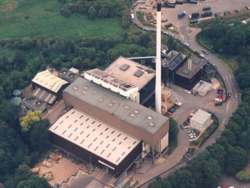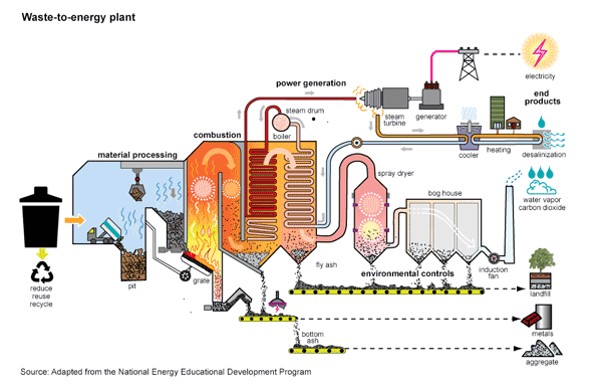Energy from Waste: Difference between revisions
| Line 29: | Line 29: | ||
|} | |} | ||
The large majority of incinerators built and operating to date in the UK are based on 'conventional' [[Combustion]] type incineration, with some development of [[Gasification]] and [[Pyrolysis]] types over the last 10 to 15 years in the UK, with varying degrees of success. These [[ATT]]/[[ACT]] types of technology were encouraged by the [[subsidy]] available for power generation under the [[Renewables Obligation]]. | The large majority of [[Incineration|incinerators]] built and operating to date in the UK are based on 'conventional' [[Combustion]] type incineration, with some development of [[Gasification]] and [[Pyrolysis]] types over the last 10 to 15 years in the UK, with varying degrees of success. These [[ATT]]/[[ACT]] types of technology were encouraged by the [[subsidy]] available for power generation under the [[Renewables Obligation]]. | ||
The three types of incineration | The three types of [[Incineration|incineration]]/[[EfW]] can have a variety of different furnaces (also termed kilns and reactors) and associated systems to ensure the uniform treatment and residence time of the waste in the kiln/reactor. The most common kilns/furnaces are [[Grate]] based (there are at least five different type of [[Grate]]), with [[Fluidised Bed]] kilns/furnaces more commonly used in [[Gasification]]. | ||
==Overview== | ==Overview== | ||
Revision as of 13:49, 9 March 2021
Energy from Waste is commonly referred to by it's acronym EfW and is the thermal treatment of waste for disposal or recovery

Context and Definition
In legal terms, a ‘waste incineration plant’ means any stationary or mobile technical unit and equipment dedicated to the thermal treatment of waste, with or without recovery of any energy generated, or whether the gases resulting from the thermal treatment are subsequently incinerated [1][2]. If the Incinerator can be shown to meet the energy efficiency measurement of R1 it can be classified as a recovery facility, if it cannot it is classified as a disposal facility[3]. This means that an incinerator that generates power, and is a net exporter of power, can be described as an Energy from Waste (EfW) facility. An incinerator that is an EfW facility that meets the R1 criteria is the only type of incinerator under the legislation that can legitimately describe itself as an Energy Recovery Facility (ERF).
The most recent recent BREF guidance[4] also sets out how incinerators can be described by:
- waste origin (e.g. Municipal Incinerators), and in WikiWaste includes Residual Waste EFW and Biomass Waste EFW,
- the nature of the waste (e.g. Hazardous Waste Incinerators), and in WikiWaste includes Hazardous Waste Incineration and Clinical Waste Incineration (which may or may not be EfW
- the method/type of incineration (e.g. High Temperature Incinerators) (which may or may not be EfW)
However, there are a range of other terms used in the sector to describe different types of incineration and Energy from Waste, the kiln/furnace used, and the subsidy that may apply to them, and these are captured in the table below:
| Definitions in Legislation | Types | Temp. Range °C | Category | Kiln/Furnace/Reactor | |||
|---|---|---|---|---|---|---|---|
| Incineration | With Energy Recovery | Combustion | 800 - 1450 | Thermal Treatment | Grate | ||
| Fluidised Bed | |||||||
| Gasification | 500 - 1600 | Advanced Thermal Treatment (ATT and ACT) | Rotary | ||||
| Without Energy Recovery | Plasma | ||||||
| Pyrolysis | 250 - 700 | Advanced Thermal Treatment (ATT and ACT) | Heated Tube | ||||
| Surface contact | |||||||
The large majority of incinerators built and operating to date in the UK are based on 'conventional' Combustion type incineration, with some development of Gasification and Pyrolysis types over the last 10 to 15 years in the UK, with varying degrees of success. These ATT/ACT types of technology were encouraged by the subsidy available for power generation under the Renewables Obligation.
The three types of incineration/EfW can have a variety of different furnaces (also termed kilns and reactors) and associated systems to ensure the uniform treatment and residence time of the waste in the kiln/reactor. The most common kilns/furnaces are Grate based (there are at least five different type of Grate), with Fluidised Bed kilns/furnaces more commonly used in Gasification.
Overview
The energy produced by an EfW facility can either be converted to electricity to boost the National Grid and/or provide heat in the form of hot water or steam for use by nearby developments. A plant facilitating the generation of electrical power and recovery of usable heat from a combustion process is termed a Combined Heat and Power (CHP) plant and it is more efficient than EfW that is focused on power generation alone. Energy from Waste facilities can be used to generate base load power as they produce a steady, reliable amount of energy but generally cannot be adjusted to meet peak demands. The development of an EfW plant is complex, with many inter-locking requirements for successful delivery[5].
In the most widely used EfW process, waste is treated via Combustion on a moving Grate. Air is introduced above and beneath the Grate in carefully controlled amounts to ensure proper Combustion. Good combustion is needed to manage the emissions from an EfW facility. The hot gases are then released are directed to a boiler to recover the heat. The combustion gases are then cleaned in several stages to strict standards set by the Industrial Emissions Directive, which are monitored by the Environment Agency (EA) in England.

Inputs
Often, but not in all cases, before waste is inputted into the EfW process a pre-treatment of this waste is undertaken at the EfW plant or in a separate facility that feeds the plant. This can include sorting and preparation processes to produce a Waste Derived Fuel that extracts the recyclable material, is able to manipulate the properties of the feedstock such as Calorific Value, Biomass content, Moisture Content and the size of the feedstock particles through processes like shredding. Different types of pre-treatment include subjecting waste to a Waste to Fuel MRF, Mechanical Biological Treatment (MBT), or Mechanical Heat Treatment (MHT)[6].
The application of EfW in the market is captured in WikiWaste based on Residual Waste EFW (comprising both untreated and treated Black Bag waste) and Biomass Waste EFW (comprising primarily Wood Waste EFW but including Sewage Sludge EFW and Agricultural Waste EFW).
The biogenic portion of the feedstock entering an EfW facility is considered to be Biomass and is classified as renewable for that proportion of the waste (and therefore eligible for subsidies e.g. ROC, RHI)[7].
Outputs
Aside from the desired electricity, heat, steam or chemicals (including fuels) generated from the Energy from Waste process; a range of by-products are also produced.The by-products produced from EfW processes vary in composition and quantity depending on the type of waste used as a feedstock, and the technology implemented[8].
The residual Incinerator Bottom Ash or IBA left after the combustion process is generally around 20% of the input tonnage by weight for a Residual Waste EFW plant, but will vary in quantity and chemical composition depending on the composition of the waste feedstock. This often contains minerals and metals along with non-combustible ash, which is increasingly being recycled into Secondary Aggregates, with some being used for the building of roads once processed (after processing IBA is termed IBBA[8].
The combustion gases from EfW are cleaned in several stages to a strict standard set by the Waste Incineration Directive (WID), which are monitored by the Environment Agency (EA) in England. This gas cleaning results in a residual Flue Ash which is around 3% of the overall input to the plant by weight depending on the level of gas cleaning required. Fly Ash and Air Pollution Control (APC) residues are often combined. APC residues contain ash, carbon and lime in varying quantities and is considered a Hazardous Waste to be disposed of in a Hazardous Landfill, or sometimes to be further processed through washing or stabilisation in order to make it a non-hazardous waste and allow it to be disposed of in a Non-hazardous Landfill[8].
The Syngas produced from Advanced Conversion Technologies is comprised of hydrogen, carbon monoxide and methane. This is often combusted in order to generate electricity or in Waste to Chemicals processes it can be turned into a fuel[8].
Emissions
The standards for emissions limits, monitoring, waste reception and treatment standards that are acceptable for waste incineration plants were set in the Waste Incineration Directive (2000/76/EC) and updated in the Industrial Emissions Directive (2010/75/EU)[2]. The Industrial Emissions Directive provides the framework for regulating across the EU and requires such installations to hold a Permit based on the use of Best Available Technique (BAT).
On the 3rd December 2019 new EU standards were published for waste incineration [4] for new emissions, monitoring and efficiency standards. The new specifications stem from a review of Best Available Technique (BAT) Reference Document (BREF) for Waste Incineration.
References
- ↑ As an example, a Pyrolysis facility that burnt the produced Syngas to generate electricity would be Incineration, whereas a Pyrolysis facility that processed Syngas for vehicle fuel would not be classed as an incinerator
- ↑ 2.0 2.1 European Commission, 2010 Industrial Emissions Directive 2010/75/EU of the European Parliament and of the Council of 24 November 2010 on industrial emissions (integrated pollution prevention and control). Official Journal of the European Union.
- ↑ https://data.gov.uk/dataset/8287c81b-2288-4f14-9068-52bfda396402/r1-status-of-incinerators-in-england
- ↑ 4.0 4.1 BAT and BREF for Waste incineration
- ↑ WRAP, 2012. EfW Development Guidance. Waste and Resources Action Programme.
- ↑ Defra, 2014. Energy from Waste: A guide to the debate February 2014 (revised edition). London.
- ↑ LCCC, 2019. Contracts for Difference Generator Guide. Low Carbon Contracts Company. London.
- ↑ 8.0 8.1 8.2 8.3 WRAP, 2019. EfW Outputs and Residues Guidance on the management of energy outputs and residues including air pollution control residues and incinerator bottom ash. EfW Development Guidance. [online] [Accessed 30 Oct. 2019].
